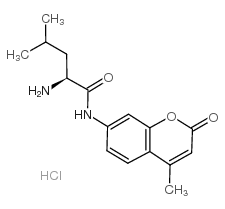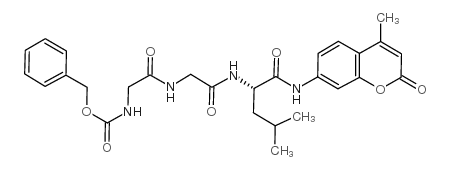L-LEUCINE-7-AMINO-4-METHYLCOUMARIN HCL

L-LEUCINE-7-AMINO-4-METHYLCOUMARIN HCL structure
|
Common Name | L-LEUCINE-7-AMINO-4-METHYLCOUMARIN HCL | ||
|---|---|---|---|---|
| CAS Number | 62480-44-8 | Molecular Weight | 324.80300 | |
| Density | N/A | Boiling Point | 503ºC at 760 mmHg | |
| Molecular Formula | C16H21ClN2O3 | Melting Point | 248ºC | |
| MSDS | USA | Flash Point | 258ºC | |
Use of L-LEUCINE-7-AMINO-4-METHYLCOUMARIN HCLL-Leucine-7-amido-4-methylcoumarin (Leu-AMC) hydrochloride is a bright blue fluorogenic peptidyl substrate for LAP3 (leucine aminopeptidase). L-Leucine-7-amido-4-methylcoumarin hydrochloride can be used for leucine aminopeptidase inhibition assays in vitro[1]. |
| Name | L-Leucine-(4-methyl-7-coumarinylamide) hydrochloride |
|---|---|
| Synonym | More Synonyms |
| Description | L-Leucine-7-amido-4-methylcoumarin (Leu-AMC) hydrochloride is a bright blue fluorogenic peptidyl substrate for LAP3 (leucine aminopeptidase). L-Leucine-7-amido-4-methylcoumarin hydrochloride can be used for leucine aminopeptidase inhibition assays in vitro[1]. |
|---|---|
| Related Catalog | |
| In Vitro | In leucine aminopeptidases inhibition assays in KB 3.1 cells. Compounds 3 and 5 are observed to weakly inhibit the biofilm formation by S. aureus and constrain inhibitory activity of ʟ-Leu-AMC hydrolysis in KB 3.1 cells[1]. The amount of hydrolyzed 7-amino-4-methylcoumarin (AMC) is determined in a fluorescence spectrophotometer (excitation/emission: 365/440 nm)[1]. |
| References |
| Boiling Point | 503ºC at 760 mmHg |
|---|---|
| Melting Point | 248ºC |
| Molecular Formula | C16H21ClN2O3 |
| Molecular Weight | 324.80300 |
| Flash Point | 258ºC |
| Exact Mass | 324.12400 |
| PSA | 85.33000 |
| LogP | 3.98860 |
| InChIKey | VCRXITKKWBOQRZ-ZOWNYOTGSA-N |
| SMILES | Cc1cc(=O)oc2cc(NC(=O)C(N)CC(C)C)ccc12.Cl |
| Storage condition | -20°C |
Synonym:None known Section 2 - COMPOSITION, INFORMATION ON INGREDIENTS
Risk Phrases: None Listed. Section 3 - HAZARDS IDENTIFICATION EMERGENCY OVERVIEW
The toxicological properties of this material have not been fully investigated. Potential Health Effects Eye: May cause eye irritation. Skin: May cause skin irritation. Ingestion: May cause irritation of the digestive tract. The toxicological properties of this substance have not been fully investigated. Inhalation: May cause respiratory tract irritation. The toxicological properties of this substance have not been fully investigated. Chronic: No information found. Section 4 - FIRST AID MEASURES Eyes: Flush eyes with plenty of water for at least 15 minutes, occasionally lifting the upper and lower eyelids. Get medical aid. Skin: Get medical aid. Flush skin with plenty of water for at least 15 minutes while removing contaminated clothing and shoes. Wash clothing before reuse. Ingestion: Never give anything by mouth to an unconscious person. Get medical aid. Do NOT induce vomiting. If conscious and alert, rinse mouth and drink 2-4 cupfuls of milk or water. Inhalation: Remove from exposure and move to fresh air immediately. If not breathing, give artificial respiration. If breathing is difficult, give oxygen. Get medical aid. Notes to Physician: Section 5 - FIRE FIGHTING MEASURES General Information: As in any fire, wear a self-contained breathing apparatus in pressure-demand, MSHA/NIOSH (approved or equivalent), and full protective gear. During a fire, irritating and highly toxic gases may be generated by thermal decomposition or combustion. Extinguishing Media: Use agent most appropriate to extinguish fire. Use water spray, dry chemical, carbon dioxide, or appropriate foam. Section 6 - ACCIDENTAL RELEASE MEASURES General Information: Use proper personal protective equipment as indicated in Section 8. Spills/Leaks: Vacuum or sweep up material and place into a suitable disposal container. Clean up spills immediately, observing precautions in the Protective Equipment section. Avoid generating dusty conditions. Provide ventilation. Section 7 - HANDLING and STORAGE Handling: Wash thoroughly after handling. Use with adequate ventilation. Minimize dust generation and accumulation. Avoid contact with eyes, skin, and clothing. Keep container tightly closed. Avoid ingestion and inhalation. Storage: Store in a tightly closed container. Store in a cool, dry, well-ventilated area away from incompatible substances. Section 8 - EXPOSURE CONTROLS, PERSONAL PROTECTION Engineering Controls: Facilities storing or utilizing this material should be equipped with an eyewash facility and a safety shower. Use adequate ventilation to keep airborne concentrations low. Exposure Limits CAS# 62480-44-8: Personal Protective Equipment Eyes: Wear appropriate protective eyeglasses or chemical safety goggles as described by OSHA's eye and face protection regulations in 29 CFR 1910.133 or European Standard EN166. Skin: Wear appropriate protective gloves to prevent skin exposure. Clothing: Wear appropriate protective clothing to prevent skin exposure. Respirators: A respiratory protection program that meets OSHA's 29 CFR 1910.134 and ANSI Z88.2 requirements or European Standard EN 149 must be followed whenever workplace conditions warrant respirator use. Section 9 - PHYSICAL AND CHEMICAL PROPERTIES Physical State: Solid Color: almost white Odor: none reported pH: Not available. Vapor Pressure: Not available. Viscosity: Not available. Boiling Point: Not available. Freezing/Melting Point: 248 deg C Autoignition Temperature: Not applicable. Flash Point: Not applicable. Explosion Limits, lower: Not available. Explosion Limits, upper: Not available. Decomposition Temperature: > 248 deg C Solubility in water: Specific Gravity/Density: Molecular Formula: C16H20N2O3.HCl Molecular Weight: 288.1516 Section 10 - STABILITY AND REACTIVITY Chemical Stability: Stable at room temperature in closed containers under normal storage and handling conditions. Conditions to Avoid: Incompatible materials, dust generation, excess heat. Incompatibilities with Other Materials: Oxidizing agents. Hazardous Decomposition Products: Nitrogen oxides, carbon monoxide, irritating and toxic fumes and gases, carbon dioxide. Hazardous Polymerization: Has not been reported Section 11 - TOXICOLOGICAL INFORMATION RTECS#: CAS# 62480-44-8 unlisted. LD50/LC50: Not available. Carcinogenicity: L-Leucine-(4-Methyl-7-Coumarinylamide) Hydrochloride - Not listed by ACGIH, IARC, or NTP. Section 12 - ECOLOGICAL INFORMATION Section 13 - DISPOSAL CONSIDERATIONS Dispose of in a manner consistent with federal, state, and local regulations. Section 14 - TRANSPORT INFORMATION IATA Not regulated as a hazardous material. IMO Not regulated as a hazardous material. RID/ADR Not regulated as a hazardous material. Section 15 - REGULATORY INFORMATION European/International Regulations European Labeling in Accordance with EC Directives Hazard Symbols: Not available. Risk Phrases: Safety Phrases: S 28A After contact with skin, wash immediately with plenty of water. S 37 Wear suitable gloves. S 45 In case of accident or if you feel unwell, seek medical advice immediately (show the label where possible). WGK (Water Danger/Protection) CAS# 62480-44-8: No information available. Canada None of the chemicals in this product are listed on the DSL/NDSL list. CAS# 62480-44-8 is not listed on Canada's Ingredient Disclosure List. US FEDERAL TSCA CAS# 62480-44-8 is not listed on the TSCA inventory. It is for research and development use only. SECTION 16 - ADDITIONAL INFORMATION N/A |
| Personal Protective Equipment | Eyeshields;Gloves;type N95 (US);type P1 (EN143) respirator filter |
|---|---|
| Safety Phrases | S22-S24/25 |
| RIDADR | NONH for all modes of transport |
| HS Code | 2932209090 |
| Precursor 0 | |
|---|---|
| DownStream 1 | |
| HS Code | 2932209090 |
|---|---|
| Summary | 2932209090. other lactones. VAT:17.0%. Tax rebate rate:13.0%. . MFN tariff:6.5%. General tariff:20.0% |
|
Screening the Medicines for Malaria Venture "Malaria Box" against the Plasmodium falciparum aminopeptidases, M1, M17 and M18.
PLoS ONE 10(2) , e0115859, (2015) Malaria is a parasitic disease that remains a global health burden. The ability of the parasite to rapidly develop resistance to therapeutics drives an urgent need for the delivery of new drugs. The M... |
|
|
Enzyme-based resource allocated decomposition and landscape heterogeneity in the Florida Everglades.
J. Environ. Qual. 37 , 972-6, (2008) Enzyme catalyzed reactions are generally considered the rate-limiting step in organic matter degradation and may be significantly influenced by the structure and composition of plant communities. Chan... |
| MFCD00043262 |
| 2-amino-4-methyl-N-(4-methyl-2-oxochromen-7-yl)pentanamide,hydrochloride |
| H-Leu-AMC.HCL |
 CAS#:97792-39-7
CAS#:97792-39-7
